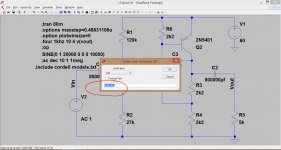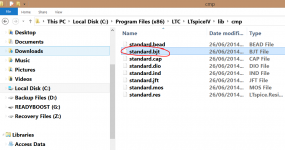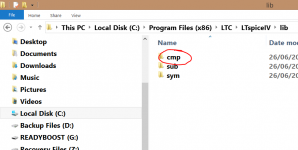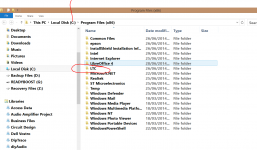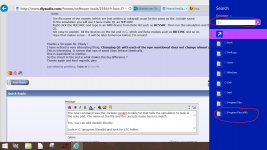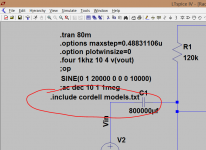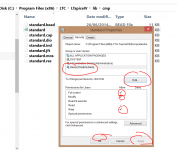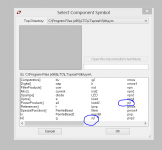Hi and sorry if i say something stupid but i am only a beginner
With the help of this community i have discovered LTSpice
I would like to add some models of bjts to the default library that is limited to few of them
Are this models sold somewhere ? Like collections or so ?
Thanks a lot and kind regards, gino
With the help of this community i have discovered LTSpice
I would like to add some models of bjts to the default library that is limited to few of them
Are this models sold somewhere ? Like collections or so ?
Thanks a lot and kind regards, gino
You are having fun 
There are a few ways to do this. This is the easy way. Attached is a list of Bob Cordells models. Put this IN THE SAME FOLDER as the circuit you have been working on. That is important.
Here is an attached folder to show you what to do. Download it and extraxt it so that its a normal folder. It contains the Radford preamp and a list of models.
Run the simulation and look for the NEW command I have added called .include cordell models.txt
The file name of the models (which are just written in notepad) must be the same as the .include name.
In the simulation you will see I have made Q1 an MJE340C
Right click the MJE340C and type in an NPN device from Bobs list such as BC550C. Then run the simulation and its now using that device for Q1.
Not easy to explain. All the devices on the list end in C, which are Bobs models such as BD139C and so on.
Hope that makes sense... it will be later tomorrow before I'm around.
There are a few ways to do this. This is the easy way. Attached is a list of Bob Cordells models. Put this IN THE SAME FOLDER as the circuit you have been working on. That is important.
Here is an attached folder to show you what to do. Download it and extraxt it so that its a normal folder. It contains the Radford preamp and a list of models.
Run the simulation and look for the NEW command I have added called .include cordell models.txt
The file name of the models (which are just written in notepad) must be the same as the .include name.
In the simulation you will see I have made Q1 an MJE340C
Right click the MJE340C and type in an NPN device from Bobs list such as BC550C. Then run the simulation and its now using that device for Q1.
Not easy to explain. All the devices on the list end in C, which are Bobs models such as BD139C and so on.
Hope that makes sense... it will be later tomorrow before I'm around.
Attachments
Good morning Mr. Mooly 
Sorry for the late reply but yesterday evening i was busy trying to get down the 2nd harmonic in a single npn buffer ... no way !
But i could decrease the 3rd that i understand is more nasty
I have created a folder with all the circuits. So i will place it there.
Thanks a lot indeed !
I will do it this evening after work.
By the way i was thinking that it would be nice that the various semiconductors makers provide this data, like a think LT does. Great Company indeed ... such a tool for free
Yes i am having quite a fun. Honestly without this tool i would not had any possibility to calculate a circuit.
It is really a great tool. And it helps to understand how circuits works.
Have a nice day. Kind regards, gino
Sorry for the late reply but yesterday evening i was busy trying to get down the 2nd harmonic in a single npn buffer ... no way !
But i could decrease the 3rd that i understand is more nasty
You are having fun
There are a few ways to do this.
This is the easy way.
Attached is a list of Bob Cordells models. Put this IN THE SAME FOLDER as the circuit you have been working on. That is important.
I have created a folder with all the circuits. So i will place it there.
Here is an attached folder to show you what to do. Download it and extraxt it so that its a normal folder.
It contains the Radford preamp and a list of models.
Run the simulation and look for the NEW command I have added called .include cordell models.txt
The file name of the models (which are just written in notepad) must be the same as the .include name.
In the simulation you will see I have made Q1 an MJE340C
Right click the MJE340C and type in an NPN device from Bobs list such as BC550C. Then run the simulation and its now using that device for Q1.
Not easy to explain. All the devices on the list end in C, which are Bobs models such as BD139C and so on.
Hope that makes sense... it will be later tomorrow before I'm around
Thanks a lot indeed !
I will do it this evening after work.
By the way i was thinking that it would be nice that the various semiconductors makers provide this data, like a think LT does. Great Company indeed ... such a tool for free
Yes i am having quite a fun. Honestly without this tool i would not had any possibility to calculate a circuit.
It is really a great tool. And it helps to understand how circuits works.
Have a nice day. Kind regards, gino
You are having fun
There are a few ways to do this. This is the easy way. Attached is a list of Bob Cordells models. Put this IN THE SAME FOLDER as the circuit you have been working on. That is important.
Here is an attached folder to show you what to do. Download it and extraxt it so that its a normal folder.
It contains the Radford preamp and a list of models.
Run the simulation and look for the NEW command I have added called .include cordell models.txt
Good evening ! i cannot find the new command
But i have been able to use the BD139C and the BC550C writing them in the window.
Is there a way to make the Cordell's models to show up in the list when picking up a transistor ?
That would be very very nice indeed.
The file name of the models (which are just written in notepad) must be the same as the .include name.
In the simulation you will see I have made Q1 an MJE340C
Right click the MJE340C and type in an NPN device from Bobs list such as BC550C. Then run the simulation and its now using that device for Q1.
Not easy to explain. All the devices on the list end in C, which are Bobs models such as BD139C and so on.
Hope that makes sense... it will be later tomorrow before I'm around
Thanks a lot again Mr. Mooly !
I have noticed a very interesting thing. Changing Q1 with each of the npn mentioned does not change almost at all the fft.
This is interesting. It seems that npn of same class behave identically.
One is equivalent to another.
So the circuit in the end is what makes the big difference ?
Thanks again and kind regards, gino
Last edited:
The new command was the .include cordell models.txt that tells the simulation to look at the note pad file of the same name that you have in the same folder as the sim. The name of the file and the .include name have to match but can be anything you want.
Yes, I think you can add models directly.
Look in C:\program filesx86 and look for LTC folder. Click your way through it and look for the "lib" folder. Click lib and then look for "cmp". Open the cmp folder and look for standard.bjt . Open that with NOTEPAD. I think you can copy and paste newmodels for transistors in there.
you can copy and paste newmodels for transistors in there.
I've just tried it (but I'm on Windows 8.1) and its not letting me save the file... so I would have to investigate that at some point. I'm sure I did do it on Vista though.
Yes, its surprising what you can try and get to work. Even a 2n3055
Yes, I think you can add models directly.
Look in C:\program filesx86 and look for LTC folder. Click your way through it and look for the "lib" folder. Click lib and then look for "cmp". Open the cmp folder and look for standard.bjt . Open that with NOTEPAD. I think
I've just tried it (but I'm on Windows 8.1) and its not letting me save the file... so I would have to investigate that at some point. I'm sure I did do it on Vista though.
Yes, its surprising what you can try and get to work. Even a 2n3055
Attachments
OK, got it to work. I added the MJE340C to the library by just copy and pasting the text from Bobs notepad file into the "standard bjt" file.
To get it to save in W8.1 I had to right click the "standard bjt" file and change the permissions to allow full control. This is where different PC's might be different.
To get it to save in W8.1 I had to right click the "standard bjt" file and change the permissions to allow full control. This is where different PC's might be different.
Attachments
OK, got it to work.
I added the MJE340C to the library by just copy and pasting the text from Bobs notepad file into the "standard bjt" file.
To get it to save in W8.1 I had to right click the "standard bjt" file and change the permissions to allow full control. This is where different PC's might be different.
Hi and good evening !
Yes i follow the first method and i can get the Cordell bjts inside the schema
Thank you !
I think that at this point i have enough stuff to study for the next 6 months
I will start copying and simulating some circuits of preamp/amp to get used with the commands
Again about models it would be very nice that manufacturers provide them as they provide datasheet
Anyway i take the opportunity to thank you again for the exceptional and decisive support
Kindest regards, gino
6 months (lol) And the rest 
If its any help, here is a list of some models from Linear technology. Its only a notepad file but its over the forum limit so that's why its zipped.
If you want a few LT spice circuits to play with then just say so and I'll upload them. And there are a few examples in the LT program files if you have a look.
If its any help, here is a list of some models from Linear technology. Its only a notepad file but its over the forum limit so that's why its zipped.
If you want a few LT spice circuits to play with then just say so and I'll upload them. And there are a few examples in the LT program files if you have a look.
Attachments
6 months (lol) And the rest
If its any help, here is a list of some models from Linear technology. Its only a notepad file but its over the forum limit so that's why its zipped.
If you want a few LT spice circuits to play with then just say so and I'll upload them. And there are a few examples in the LT program files if you have a look.
Hi and thank you very much for the models again and for your very kind offer of help
but i really think that i should give a look at Cordell's book first
I hope it will be useful at least for the english
I need to try at least to catch the very basic just to hope to ask some reasonable question.
I will read the book first .. it should arrive soon.
Thanks again, gino
Good morning MR Mooly
its me again ... sorry
Just one question ... in the waiting for the book
I am focused now on the very very basic circuit ... the one depicted here below
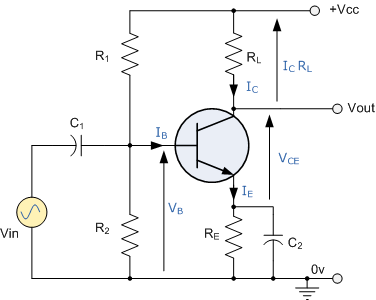
just to try to understand the effects of changing the various components
I am looking only to the fft and i have noticed something
The fft looks better if:
1) i increase the supply voltage
2) i reduce the gain on the npn
To do so i have used a more powerful npn
Now the weird question.
I have seen and bought some spectacular npn bjt from Toshiba
I am attaching the pdf here under
http://www.jmnic.com/pdf/2sc/2SC2238A.pdf
Questions:
1) can i be confident that this bjt will show similar results to that of the lower power bjt ?
2) which parameters in the data sheet i have to look at to understand if the results with LTSpice will be equal of even better ?
I have decided to go for a to220 package because it seems to me easier to heatsink ... i intend to use high voltage supply (around 60V like the Radford).
Maybe i am completely on the wrong path but i feel that high voltage supplies give spectacular results with the right bjt. I will upload a fft ... it is impressive ... no 3rd to speak of
My main goal remains always the same ... optimize the very very very basic circuit to see which level of performance i can get by "stretching" a very high quality npn.
To build a one bjt line preamp.
Then i will build it and take it to a friend place ... who has a high price tube line stage ... i would like to make him look like this
It is my mid term challenge
Thank you very much again
Have a nice day
Kindest regards, gino
Last edited:
Does the library include jfet models, by chance?
Hi i am attaching the part of the txt where all the components are listed
*
* Cordell Models - 04/20/2011
*
* copyright Cordell Audio April 2011
*
* BJT Models
*
* 2N3904 2N3906
* 2N4401 2N4403
* 2N5087 2N5089
* 2N5210
* 2N5551 2N5401
* 2SC3503 2SA1381
* 2SC3601 2SA1407
* BC550 BC560
* BD139 BD140
* MJE243 MJE253
* MJE340 MJE350
* MJE15032 MJE15033
* MJL21194 MJL21193
* MJL3281 MJL1302
* MJL4281 MJL4302
* NJL3281 NJL1302
Regards, gino
The one transistor gain stage as drawn probably isn't practical because of C2 which causes the gain to increase dramatically. The exact gain figure and response of the stage really does now depend on the transistor and its properties rather than the other components defining those properties. It would be much more usual to include a series resistor with R2 to give a defined and repeatable gain.
All these single gain stage circuits (like this and the Radford) always generate 2nd (even) harmonic distortion and not 3rd odd order. And that is one of the reasons many like the sound of these type of circuits.
(its easy to chase numbers in simulation. I've had spectacular results from trying strange or non obvious devices but they wouldn't translate to real world builds)
All these single gain stage circuits (like this and the Radford) always generate 2nd (even) harmonic distortion and not 3rd odd order. And that is one of the reasons many like the sound of these type of circuits.
(its easy to chase numbers in simulation. I've had spectacular results from trying strange or non obvious devices but they wouldn't translate to real world builds)
Does the library include jfet models, by chance?
A few.
Attachments
The one transistor gain stage as drawn probably isn't practical because of C2 which causes the gain to increase dramatically. The exact gain figure and response of the stage really does now depend on the transistor and its properties rather than the other components defining those properties. It would be much more usual to include a series resistor with R2 to give a defined and repeatable gain.
Good morning Mr Mooly
sorry i should have said that ... no C2 here ...
i am at work
Next time i will upload the actual spice schematic ... that is without C2 of course if not i would have seen the gain on the simulation i guess
The gain is no more than 2 in my tests
All these single gain stage circuits (like this and the Radford) always generate 2nd (even) harmonic distortion and not 3rd odd order.
And that is one of the reasons many like the sound of these type of circuits.
Interesting. The thing is that the 2nd is 100 dB below the fundamental and the 3rd ... i cannot see it almost
So there is indeed some 2nd ... but extremely low
Much lower than in some commercial line preamp i mean
(its easy to chase numbers in simulation. I've had spectacular results from trying strange or non obvious devices
I see ... but i am focused in very obvious devices ... like better npns.
With better performance.
I feel a sort of prejudice ... that high supply voltage is only for tubes.
Why if high supply voltages give better results ? and if the component can bear them of course ... but with small currents high voltages are perfectly fine.
but they wouldn't translate to real world builds)
i agree ... i have been told very clearly that sim is just a start , a part of the story ... than quality of lay out and above all of the power supply play a decisive role
But maybe this is a small step for the mankind but a giant leap for ginetto
Thanks a lot again.
Have a nice day, gino
Last edited:
- Status
- This old topic is closed. If you want to reopen this topic, contact a moderator using the "Report Post" button.
- Home
- Design & Build
- Software Tools
- How to find Spice models of bjts
